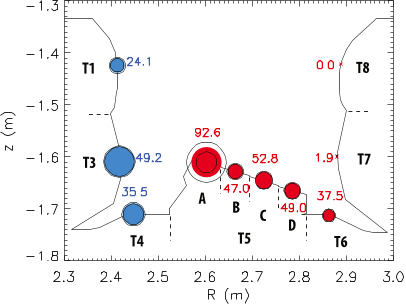




Did you find this useful? Give us your feedback









8 citations
...JET reported 1800 events over 2800 shots with the ITER-like wall in one analysis but with no lasting effects on the plasma.(32) In contrast, analysis of Alcator C-MOD (molybdenum walls) found 25% of disruptions from 2012–2016 could be attributed to UFOs...
[...]
8 citations
6 citations
6 citations
4 citations
708 citations
281 citations
264 citations
235 citations
197 citations
In limited plasmas, W could originate from W-coated neutral beam shine-through protection tiles as well as from few outer poloidal limiters, recessed inner limiter tiles and restraint ring protection tiles.
The probability of TIEs occurring in limited plasmas is very low (≤ 10 mHz) and only ∼ 7% of all events occur in this configuration.
Following a disruption, light scattered from dust particles (through Mie scattering) that have been heated or ablated by the laser beam is also seen [9].
Since both stainless steel (material of the support structures) and Inconel (support structure of the divertor W mono-block tiles) are made up of Ni, Fe and Cr (althoughin different percentages), dust particles from these parent structures could lead to events of either of these elements.
Since the normalization of the number of events has been performed over total plasma-time, this increase is probably caused by simple cumulative effects due to higher fraction of total time operated at high input power.
Reciprocating probe (RCP) plunges have shown to be the cause of 15 events (< 1%), while arcs at the lower hybrid (LH) antennas are responsible for 7 events (< 0.5%).
Since the horizontal part of the divertor is a deposition zone for material coming from the main chamber, dust which accumulates in this region could partly be the cause of the occurrence of TIEs.
Depending on their composition and size, if such particles reach the plasma core they can perturb it with intense radiation spikes which have been seen to lead to MARFE (stranding for MultifacetedAsymmetric Radiation From the Edge) instabilities or disruptions, especially in long pulse operation [4].
Due to the fact that the normalization has been performed over total plasma-time in each specific configuration, the TIE-probability shown in these plots will increase with the fraction of total time spent at higher heating powers.
The number of events detected by the HRTS diagnostic has been seen to decrease constantly during the experimental campaigns with the ILW, dropping of a factor ∼ 4 from the start of the first plasmas to the end of the campaign.
In order to correctly normalize the event distributions, a database containing the total plasma operation time (in steps of 10 ms) for each geometrical configuration and each correlation quantity listed above has been created.
Correlation with disruption force reveals that the number of detected dust particles increases strongly with disruption force (figure 3) and confirms the results shown in [10].
The understanding of dust production and control in future tokamaks such as ITER is a major concern not only for safety reasons and for diagnostic interpretation (see e.g. [1, 2, 3]), but also for reliable plasma operation.
Configurations with the outer strike point on vertical tile 7 seem to be less prone to TIE-occurrence than those with the outer strike point on the horizontal tiles 5 or 6 (1.9 mHz vs. 40 − 50 mHz).